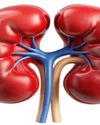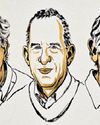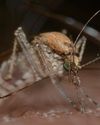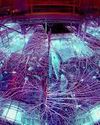Prøve GULL - Gratis
Emerging zoonotic viral disease caused by Nipah virus; a spill over from fruit bats to human
Scientific India
|March-April 2023
Nipah virus (NiV), an emerging zoonotic virus, Nbelongs to the family Paramyxoviridae subfamily Paramyxovirinae and genus Henipavirus.
-

The natural reservoirs of the virus are fruit bats of the genus Pteropus (Thomas et al., 2019). NiV has 18,252 nucleotides long negative-sense ssRNA genome which is nonsegmented (Prescott et al 2012) packed in a helical nucleocapsid. The Henipavirus genus also includes pathogenic Hendra virus and nonpathogenic Cedar virus discovered in the years 1994 and 2009 respectively. Both Hendra virus and Nipah virus are enveloped and pleomorphic with an average diameter of about 500 nm (Ong and Wong, 2015). Six structural proteins are encoded by the NiV genome, namely, P (phosphoprotein), M (matrixprotein), F (fusion protein), G (receptor-binding glycoprotein), and L (RNA-dependent RNA polymerase). The interaction and attachment of the NiV G protein with the host cell ephrin B2 and/or B3 receptor activates the NiV F protein which lead to the internalisation of the virus through fusion of the viral envelope and host cell membrane (Ong and Wong, 2015).
Origin
NiV was discovered from an outbreak of respiratory and neurological disease in pigs and acute encephalitis with high mortality in workers handling those pigs in Malaysia during 1998-1999 (MacLachlan and Dubovi, 2010). The virus was first isolated by Chua et al. from the 1999 outbreak from the human cases with encephalitis from Sungai Nipah in Port Dickson, Malaysia and hence acquired the name "Nipah". The sample used for viral isolation was CSF of two patients and IgM antibodies against Hendra virus was found in the sample using IgM capture ELISA. The isolated virus caused syncytial formation after 5 days in Vero cell lines and was concluded as an undescribed virus related to Hendra virus of family Paramyxoviridae (Chua et al., 1999). Later the virus was isolated from the affected pigs also (MacLachlan and Dubovi, 2010).
Virus lineages
Denne historien er fra March-April 2023-utgaven av Scientific India.
Abonner på Magzter GOLD for å få tilgang til tusenvis av kuraterte premiumhistorier og over 9000 magasiner og aviser.
Allerede abonnent? Logg på
FLERE HISTORIER FRA Scientific India
Scientific India
Japanese physicists were the first to measure the most tolerant entanglement state, the W state
There are many unusual things that happen in the world of quantum physics.
3 mins
September - October 2025

Scientific India
The Fifth Force: Could It Unlock the Secret of Dark Matter?
What if the universe is powered by a force we've never seen before? For centuries, science has explained nature with four fundamental forces.
3 mins
September - October 2025

Scientific India
A flu test you can chew
As flu season nears in the northern hemisphere, scientists are exploring a surprising new way to detect infection: through taste.
1 mins
September - October 2025

Scientific India
Lab-Grown Kidney Brings Artificial Organ Dream Closer to Reality
In a major leap toward bioengineered organ replacement, scientists have successfully grown human kidney 'assembloids' in the laboratory that mimic key structural and functional features of natural kidneys.
1 min
September - October 2025

Scientific India
Your pumpkin might be hiding a toxic secret
Pumpkins, squash, zucchini, and other members of the gourd family have a surprising trait: they can take up pollutants from the soil and store them in their edible parts.
1 mins
September - October 2025

Scientific India
2025 Nobel Prize in Physics Reveals Quantum Secrets in Superconducting Circuits
The 2025 Nobel Prize in Physics has been awarded to John Clarke, Michel H. Devoret, and John M. Martinis for their pioneering experiments that brought quantum mechanics from the invisible atomic world to the macroscopic scale a system large enough to hold in your hand.
1 mins
September - October 2025

Scientific India
Genomic Evidence Redefines the Evolutionary Age of Mosquitoes
A new genetic analysis has shaken up what we thought we knew about one of humanity's most notorious pests the mosquito.
1 min
September - October 2025

Scientific India
Nobel Prize in Chemistry 2025: Building Molecular Architectures with Room to Breathe
In a scientific breakthrough that bridges molecular design with planetary-scale problems, the 2025 Nobel Prize in Chemistry has been awarded to Susumu Kitagawa, Richard Robson, and Omar Yaghi.
1 mins
September - October 2025

Scientific India
Guardians of Immunity: Nobel Prize 2025 Honors Discoveries that Keep the Immune System in Check
The 2025 Nobel Prize in Physiology or Medicine has been awarded to Mary E. Brunkow, Fred Ramsdell, and Shimon Sakaguchi for their groundbreaking discoveries in the field of peripheral immune tolerance a crucial mechanism that prevents the body's immune system from turning against itself.
1 mins
September - October 2025

Scientific India
'Is cold nuclear fusion feasible?
In early May 1989, two chemists from the University of Utah, Pons and Fleischmann, arrived in Washington, U.S.A. The aim is to present their findings to members of the US Congress.
3 mins
September - October 2025
Translate
Change font size
